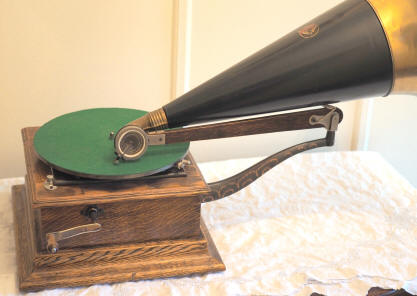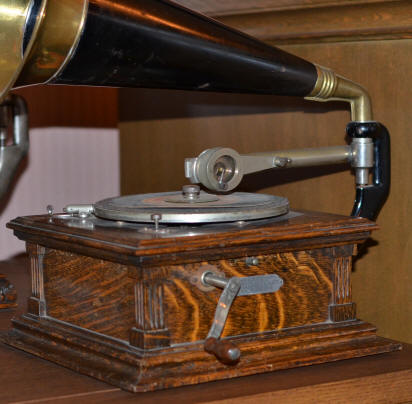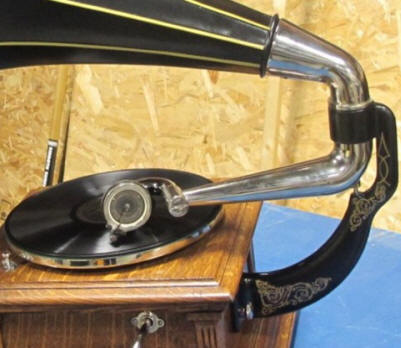
The
Victor-Victrola Page

Design
Details:
1. Horns
2. Tonearm Designs
3.
Cabinet Features
4.
Soundboxes
5.
Cranks and
Speed Controls
Pictures and details on
some
of the design features of External Horn Victor phonographs. Each sequential page covers one
aspect of the evolving designs. Advance to the next page via the link above or
at the bottom of each page
Victor Tonearms. As
early phonographs evolved, the design of the tonearms changed significantly. For
its line of external horn phonographs, Victor used three basic tonearm types.
 Integral Horn/Tonearm.
The earliest Victor models used an integral
tonearm/horn configuration. These
machines really don't have a distinct tone-arm, per se, but rather, the entry
of the horn attaches directly to the soundbox. Thus, the entire horn pivioted
along with the soundbox as as a record was played. This design, while simple, had the
disadvantage of causing rapid record wear, as the needle had to pull the mass of
the entire horn along with it as a record was played. This resulted in a lot of
force being applied to one side of the record grooves. It was also rather awkward to
manipulate, especially with the larger horns. All early disc phonographs used this design configuration; it became
obsolete with the invention of the rigid arm system in 1903. A wooden
swing-arm supported the horn/soundbox system, and allowed it to move as the
record played. These are what are termed Front Mount
styles, since the bracket that holds the horn is in the front of the machine
(facing the listener). This design was
soon replaced by the Rigid Arm/Rear Mount concept (below) on the better models,
but was continued on some of the less expensive Victors up through the early
'teens.
Integral Horn/Tonearm.
The earliest Victor models used an integral
tonearm/horn configuration. These
machines really don't have a distinct tone-arm, per se, but rather, the entry
of the horn attaches directly to the soundbox. Thus, the entire horn pivioted
along with the soundbox as as a record was played. This design, while simple, had the
disadvantage of causing rapid record wear, as the needle had to pull the mass of
the entire horn along with it as a record was played. This resulted in a lot of
force being applied to one side of the record grooves. It was also rather awkward to
manipulate, especially with the larger horns. All early disc phonographs used this design configuration; it became
obsolete with the invention of the rigid arm system in 1903. A wooden
swing-arm supported the horn/soundbox system, and allowed it to move as the
record played. These are what are termed Front Mount
styles, since the bracket that holds the horn is in the front of the machine
(facing the listener). This design was
soon replaced by the Rigid Arm/Rear Mount concept (below) on the better models,
but was continued on some of the less expensive Victors up through the early
'teens.
 Rigid
Arm. In
the fall of 1902, Victor developed a "rigid arm" system, wherein the tonearm
became a separate component from the horn, and was connected to the horn via a
slip-fit interface. In this design, the horn did not move with the tonearm, but
was now mounted rigidly to the cabinet. This reduced record wear and also made
it easier to operate the phonograph (you didn't have to move the whole horn in
order to play a record). Note the pivot joint midway down the tonearm which allows the
soundbox to swing up to make it easier to change a record or replace a needle.
The tonearm is not 'tapered' in these early designs, but remains as a straight
tube from the soundbox to the pivot joint in the rear. These are termed Rear Mount support
styles, since the bracket that holds the horn is in the rear of the
machine (away from the listener). Rigid arm designs were only produced for about
6 months, making machines with this configuration very derirable from a
collector's standpoint.
Rigid
Arm. In
the fall of 1902, Victor developed a "rigid arm" system, wherein the tonearm
became a separate component from the horn, and was connected to the horn via a
slip-fit interface. In this design, the horn did not move with the tonearm, but
was now mounted rigidly to the cabinet. This reduced record wear and also made
it easier to operate the phonograph (you didn't have to move the whole horn in
order to play a record). Note the pivot joint midway down the tonearm which allows the
soundbox to swing up to make it easier to change a record or replace a needle.
The tonearm is not 'tapered' in these early designs, but remains as a straight
tube from the soundbox to the pivot joint in the rear. These are termed Rear Mount support
styles, since the bracket that holds the horn is in the rear of the
machine (away from the listener). Rigid arm designs were only produced for about
6 months, making machines with this configuration very derirable from a
collector's standpoint.
 Taper Arm.
In April 1903, Victor incorporated a gradual taper into the
tonearm, which improved both volume and fidelity. This is due to the fact that
the tonearm's taper served as a "miniature horn" in itself, gradually increasing
in size until it connected into the horn itself. The pivot joint used in the previous design
was replaced with a "gooseneck", allowing the tonearm to be swung back when
changing a needle or record. This successful design remained in production for
many years. These are also termed Rear Mount
styles, since the bracket that holds the horn is in the rear of the machine
(away from the listener). This tapered tonearm design was used up through
the late 1920's, as it provided a much better 'impedance transitition' from
the soundbox to the horn than did the earlier configurations.
Taper Arm.
In April 1903, Victor incorporated a gradual taper into the
tonearm, which improved both volume and fidelity. This is due to the fact that
the tonearm's taper served as a "miniature horn" in itself, gradually increasing
in size until it connected into the horn itself. The pivot joint used in the previous design
was replaced with a "gooseneck", allowing the tonearm to be swung back when
changing a needle or record. This successful design remained in production for
many years. These are also termed Rear Mount
styles, since the bracket that holds the horn is in the rear of the machine
(away from the listener). This tapered tonearm design was used up through
the late 1920's, as it provided a much better 'impedance transitition' from
the soundbox to the horn than did the earlier configurations.



Integral Horn/Tonearm.
The earliest Victor models used an integral
tonearm/horn configuration. These
machines really don't have a distinct tone-arm, per se, but rather, the entry
of the horn attaches directly to the soundbox. Thus, the entire horn pivioted
along with the soundbox as as a record was played. This design, while simple, had the
disadvantage of causing rapid record wear, as the needle had to pull the mass of
the entire horn along with it as a record was played. This resulted in a lot of
force being applied to one side of the record grooves. It was also rather awkward to
manipulate, especially with the larger horns. All early disc phonographs used this design configuration; it became
obsolete with the invention of the rigid arm system in 1903. A wooden
swing-arm supported the horn/soundbox system, and allowed it to move as the
record played. These are what are termed Front Mount
styles, since the bracket that holds the horn is in the front of the machine
(facing the listener). This design was
soon replaced by the Rigid Arm/Rear Mount concept (below) on the better models,
but was continued on some of the less expensive Victors up through the early
'teens.

 Taper Arm.
In April 1903, Victor incorporated a gradual taper into the
tonearm, which improved both volume and fidelity. This is due to the fact that
the tonearm's taper served as a "miniature horn" in itself, gradually increasing
in size until it connected into the horn itself. The pivot joint used in the previous design
was replaced with a "gooseneck", allowing the tonearm to be swung back when
changing a needle or record. This successful design remained in production for
many years. These are also termed Rear Mount
styles, since the bracket that holds the horn is in the rear of the machine
(away from the listener). This tapered tonearm design was used up through
the late 1920's, as it provided a much better 'impedance transitition' from
the soundbox to the horn than did the earlier configurations.
Taper Arm.
In April 1903, Victor incorporated a gradual taper into the
tonearm, which improved both volume and fidelity. This is due to the fact that
the tonearm's taper served as a "miniature horn" in itself, gradually increasing
in size until it connected into the horn itself. The pivot joint used in the previous design
was replaced with a "gooseneck", allowing the tonearm to be swung back when
changing a needle or record. This successful design remained in production for
many years. These are also termed Rear Mount
styles, since the bracket that holds the horn is in the rear of the machine
(away from the listener). This tapered tonearm design was used up through
the late 1920's, as it provided a much better 'impedance transitition' from
the soundbox to the horn than did the earlier configurations. 
